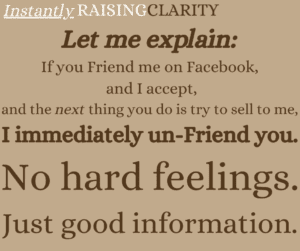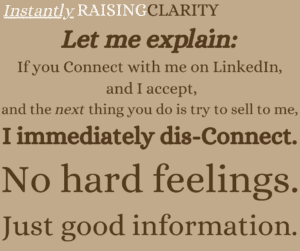
10 Jun How Fundraising Prepared Me for Authentic Selling

Fundraising prepared me for authentic selling: This photograph turned up in my search on the keyword “vulnerable.” I see why. I love her gaze, the more powerful because vulnerable. Vulnerability gives us the power we need to ask people authentically for their dollars.
What is “authentic” selling?
Believe me, this is not an empty phrase, or “nice to have” nicety, or just making nice.
If you read me at all often, you already know I’ve thought deeply about something before I blog about it.
“Selling” means offering something to someone at their request.
I’m serious
In fact, I’ve created a meme I use on social media when people try to sell me their thing without my request! Here are the two versions I made to use on my two (count ’em, 2) social media channels:


Why I need to sell: my journey thus far
I’ve been learning how to sell these past few years: I decided in January 2019, “just because” (talk about timing! I realized later) to become self-sufficient from RAISING CLARITY’s core work.
I gave up what was essentially salaried work–a baseline contract that was paying my bills but that I was using to keep myself complacent. Complacency is not my thing. I thrive on risk (a little too much sometimes), pushing my edge, vulnerability.
Too little
I knew I would have to do something differently as an entrepreneur. It turned out that the first step was to actually think of myself as an entrepreneur and not a nonprofit!
I began entrepreneurial life at an extreme I would call “anti-selling,” literally pushing away sales. I thought I was being pure, like the nonprofit world I come from as an activist, organizer, and fundraiser.
Too much
In 2019, thanks to Covid money, I jumped into a program at the other extreme, and created my Claim Your Calling intensive–to be marketed in a way I could equally call “intensive selling.”
Goldilocks found that this did not work for me either.
Although it was at this point that I researched the origin of the word “selling,” and found it was exactly as I defined to you above: offering something to someone at their request.
I was becoming financially successful, but I could tell I was out of alignment because I received physical symptoms to quit.
So I quit.
Just right?
Magically, right then, Brandon Bennett in the Mindful Leadership Group told me about George Kao, whose work I loved so much I inaugurated the RAISING CLARITY video conversations interview series with him.
I dove into George’s work. I began using a few simple elements within his comprehensive approach because they were so immediately accessible, and for me immediately applicable. After all, they were a huge relief after the “intensive selling” training I’d put into practice earlier.
Just right for me
My trial by fire had made me wiser and less resistant to selling. Which was useful, since I now realized: I need to sell my work.
Why? Because only a few people are going to find me if I rely on impressing the pants off people in conversation (my old method, plus referrals from those pantsless people), and very few of them will pay me if I don’t sell it to them, by which I mean actually offer it to them at their request. Explicitly. Without pushing them away instead.
What I’m now defining is my own approach to selling my work, which has a lot to thank my decades fundraising for.
My nascent approach to selling: vulnerability with power
My approach to selling is still in embryo, but the embryo is vulnerability with power.
Vulnerability gives us power if we use it right. If we misuse it, we become its victims. Our own victims. Not victims of someone else.
Vulnerability’s power lies in truth force, which is one translation of what Gandhi called satyagraha. I explain more below. But yes, for me, selling is that hard, and it demands that much countervailing power.
Vulnerability with power also means that I acknowledge the power I have over someone in a situation where I’m asking them to do something with their money, like fundraising or selling. I may feel scared and like they have all the power, but that’s b–shit. I do. And I can use or misuse that power.
Here is how I use my power, appropriately.
How fundraising prepared me for authentic selling
Here is why fundraising is what I call “training for vulnerability.” This is how fundraising prepares us for selling in a way that feels good and right–and works.
There are three parallels:
-
- We must first recognize we are doing one of the hardest things in our culture: asking someone else to do what you want them to do–with their money!
- We are showing trust in ourselves by asking them to trust us.
- We are showing respect for their intelligence and heart by putting ours on the line.
The First and Hardest Thing is Asking, Period
Fundraising is first and foremost asking. This is why it’s hard and so many people hate it. This is why I love its power: the power to make myself vulnerable in service to a cause.
Selling is first and foremost asking. This is why so many people hate sales and salespeople! But this is also why I’m learning to love it: I am learning to sell my work by making myself vulnerable, not lording my power over the other person.
Freedom comes from remembering: it’s not my job to control whether anyone says “yes.”
It’s my job to ask. To invite.
Just like I never fundraise from someone who hasn’t given me permission to ask them…
(Yes, people love giving, so they love being asked, even though it terrifies them–check in with your own self here, don’t you?)
…I never sell to someone who has not requested I sell to them.
Because: selling is offering something to someone at their request.
The Second and Third Things That Make Aligned Asking Possible: Trust and Respect
When we are confident enough to make ourselves vulnerable to another human being, we very often get what we ask for.
What does it take to be that confident? Preparation!
All my years doing and training in how to do one-on-one meetings with potential donors is great training for doing meetings with potential clients. Connection is primary.
Connection is not achieved by attempting to control the other person in the meeting.
Controlling ourselves, yes. And what helps me control myself is to ask (#1) with trust (#2) and respect (#3).
Trust
Trust is above all self-trust. I trust myself because I am in alignment with exactly what I am doing, and I enjoy it. I love selling in this way. The same way, in fact, I love fundraising. And for the same reasons: it’s edgy, it’s vulnerable, it’s a risk, and the results are worth it, whether or not someone says yes!
I am grateful every time someone books a meeting with me so I can share in more depth what I do than I can in my writing and videos–which I am learning to do better every day to communicate how powerful my work is for people in particular situations with specific goals and desires.
And it took me til recently to trust this approach was even a thing; that anyone did it successfully; and that I could do it. I never even guessed I could love it. Just saying. Or that I could experience success with it, sustainably, proudly, alignedly.
Respect
The last thing about preparation is knowing what you’re talking about and whom you’re talking to, and what matters to them. In fundraising, this means researching the donor and knowing your purpose widely and deeply, in your sleep. In selling, it means researching the client and knowing your work widely and deeply, in your sleep.
This is how you show respect for their intelligence and heart: by putting yours on the line, vulnerably, and this is what makes it safe enough to do that.
Honestly, if they don’t care deeply before you meet about what you care about, forget it. They’re not your client, not your donor. They’re surely someone else’s. They’re just not yours. Let them go.
And start over.
I did!



No Comments